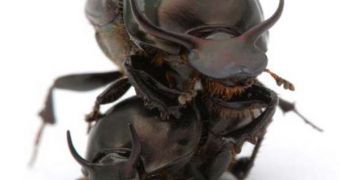Scientists were finally able to identify the strongest insect in the world. Their “champion” is a species of dung beetle apparently able to pull on roughly 1,141 times its own body weight. Translated in humans, this means that a 70-kilogram individual could pull six full double-decker buses. This ability makes the beetle Onthophagus taurus the strongest insect ever to be discovered. There is another creature in this world that can pull more than this insect, but it is an arachnid, so it does not count for this classification, LiveScience reports.
The new discovery came after months of incredibly difficult tests, in which experts made the beetles perform a variety of tasks aimed at gaging their performances. The males of the species came in two varieties, one that sports powerful horns, and one that doesn't. While the former tend to confront other horned males in the pre-mating season head-on, the latter will use sneak tactics to creep into the tunnels where the females live, while the more powerful males are not watching. These creatures are not in the habit of rolling dung balls, as most similar beetles, but rather tend to bury the stuff inside tunnels, where they lay their eggs.
In a paper detailing the findings, appearing in the current issue of the esteemed scientific journal Proceedings of the Royal Society B, researchers depict how horned males engage in combat over domination of the tunnels. “Their horns kind of meet on the shoulders, and they push each other backward and forward, and the guy being pushed will brace when pushed in the tunnel,” says Queen Mary, University of London expert Rob Knell. He and his team add that the new discovery could in the long run provide experts with more insight into evolutionary biology. For the research, Knell partnered up with University of Western Australia colleague Leigh Simmons.
In lab experiments, researchers dug small tunnels in a controlled environment, and then attached small cotton strings to each of the beetles, before allowing them to go inside. Once the creatures had made their way in, the scientists pulled on the “leash,” and the natural response of the beetles was to brace their legs, so as to prevent being dragged away. The horned males that had been fed a good diet, and were in top shape, were able to hold on with increased efficiency than those who were fed poorly, and also less than the hornless variety.

 14 DAY TRIAL //
14 DAY TRIAL //